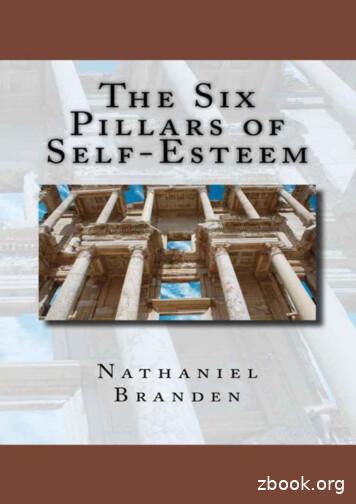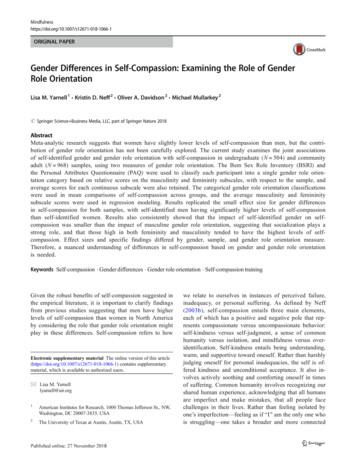Design And Analysis Of Self-excited Miniature Magnetic .
DJournal of Mechanics Engineering and Automation 5 (2015) 180-184doi: n and Analysis of Self-excited Miniature MagneticGeneratorWu-Sung Yao and Wei-Quan JianDepartment of Mechanical and Automation Engineering, National Kaohsiung First University of Science and Technology,Kaohsiung 824, TaiwanReceived: March 06, 2015 / Accepted: March 20, 2015 / Published: March 25, 2015.Abstract: Nowadays, electronic devices are more and more integrated into everyday life. These seamless integrations focus onmobility, but at the same time strive to be unobtrusive to the end user. With the introduction of personal data assistants and intelligentcellular phones for the searching of the website, true mobile computing is closer than ever. However, battery technology, which powersmost of these mobile connectivity solutions, has not kept up the same pace of improvement. The paper describes a methodology for thedesign and performance of a self-excited permanent-magnet generator applied to low power supplies. It combines an analytical fieldmodel, a lumped reluctance equivalent magnetic circuit, and an equivalent electrical circuit. An illustrated example of a 15-mW,290-r/min generator is given, and the analysis techniques are validated by measurements on a prototype system.Key words: Permanent-magnet generator, analytical field model, equivalent magnetic circuit.1. Introduction With the proliferation of portable electronicconsumer products and electronic security devices,there is an increasing need for low power supplies. Inmany applications, on-board power generation for theportable electronic products would be preferable to theuse of batteries with limited capacity and lifetime. Byincorporating a miniature permanent-magnet generator,generating electrical power is to directly convertmechanical energy to electrical energy [1]. Amechanical input power can be derived from desultorymovements, which might be associated with thestochastic motion of a limb, such as the arm, or due to aspecific action, such as cellular phone sharking [2, 3, 5].Permanent-magnet generators systems which arecapable of extracting and storing energy from bothreciprocating and intermittent motion have beenreported previously. However, in common with manyCorresponding author: Wu-Sung Yao, Ph.D., researchfields: applications of servomotor control, learning ao@nkfust.edu.tw.other direct-drive electromagnetic devices, these tendto have a relatively poor specific power capability sincethe input speed is limited. Hence, rather than directlyconverting the kinetic energy to electrical energy, it isadvantageous using efficiency and specific powercapability to initially accumulate the mechanical inputenergy. An approach is employed in kinetic“self-excited” method, which utilizes kinetic energyassociated with wrist movements [6, 7].Magnetic generator can provide a next level ofperformance required for higher endurance, higherenergy saving and reduced charging times when 3Cproducts were run out of battery. Although they willnot totally displace conventional charging system formany applications, they provide a practical solution forinconvenience from portable battery [4, 8]. Thetraditional bearings are widely used in conventional,but may take many friction consumption in machines,most of the energy consumed by friction and reducemachine efficiency. New technology is required topush the limits even further and achieve a new standardof capability in performance and throughout. In this
Design and Analysis of Self-excited Miniature Magnetic Generatorpaper, a methodology for the design and performanceof a self-excited permanent-magnet generator isdescribed. It combines an analytical field model, alumped reluctance equivalent magnetic circuit, and anequivalent electrical circuit. A magnetic generator withmagnetic bearings is proposed. Using magneticbearings element eliminates most of these consumption.The magnetic bearings consist of many non-contactelements. With the magnetic generator, the magneticforce directly engages the rotating with no mechanicalconnection. There is no mechanical friction orconcussion. Rotor of magnetic generator is forced bymagnetic force attract and repulse, but rotor may stopbecause magnetic force of magnets is consumed untilexhausted. Magnetic bearings can reduce the rate ofconsumption effectively, so we use rotating power togenerator electricity with toroid coil.The paper is organized as follows: Section 2 explainsthe design concept and magnetic field analysis; Section3 introduces the experimental evaluation; Section 4presents experimental results and discussions; andSection 5 gives conclusions.181Fig. 1Source of kinetic by magnets.Fig. 2Result of assumptions.2. Design and Magnetic Field AnalysisFig. 3Distribution of magnetic.In this study, the magnetic generator contains severalparts like power section, bearing section, coil andelectromagnetic section. In power section, the samepoles produced a vertical resistance by magnets in leftside of Fig. 1. When the magnet can be rotated with anangle, it produced not only a vertical resistance but alsoa horizontal resistance, in right side of Fig. 1. Therefore,rotor of magnetic generator can be forced by usinghorizontal resistance as like Fig. 1.In practical, the degrees of freedom of magnetsmust be limited. In left side of Fig. 2, it shows thatsame pole of magnets can produce a vertical resistancein positive direction of y axis and horizontal resistancein positive direction of x axis. In right side of Fig. 2, itshows that different pole of magnets can produce avertical resistance in negative direction of y axis andhorizontal resistance in positive direction of x axis. Thesummation of forces in y directions should be zero; in xdirection must not be zero. In other words, there is aforce in positive direction of x, and rotor of magneticgenerator is rotating by this force for self-excited.In bearing section, in order to continue kineticenergy from magnets and reduce friction, a magneticbearing for self-excited miniature magnetic generatorcan be designed as like Fig. 3. It keeps the rotor in acenter position and retaining a margin from boundary,floating the rotor onto air and avoiding collision withother parts. In which the magnetic bearing is usingradiation magnetizing, and distribution of poles isbelongs to one pole on inner diameter and one pole onouter diameter.In electromagnetic section, an induced backelectromotive force is generated in DC (direct current)brush motor when it is rotating. This back
Design and Analysis of Self-excited Miniature Magnetic Generator182electromotive force can also be a source of electricityin magnetic generator. There is a formula regarding tothe magnitude of back electromotive force,i.e., E PZ n .60aIn this formula, P represents quantity of magnets, Zrepresents quantity of conductors, a represents parallelcircuit of brush, φ represents magnetic flux, and nrepresents motor speed. In this formula, the quantity ofmagnetic poles is proportional to back electromotiveforce. Therefore, we can increase quantity of magneticpoles in magnetic generator to produce more electricityas shown in Fig. 4.In coil section, electricity can be produced formagnets having a relative movement with coil, andproduce a resistance to the movement of magnets orcoils.In order to eliminate this resistance, a toroid coil (asshown in Fig. 6) can be given which could not producea resistance to external magnetic field, because it iscircularity and it can generate a closed-loop ofmagnetic field in the interior of toroid coil. Fig. 6shows a picture of toroid coil and magnetic field whichcan be produced in toroid coil. The prototype ofmagnetic generator is shown in Fig. 7.3. Experimental EvaluationFig. 8 shows the experimental setup for the powersection, used a general bearing replaced magneticbearings to keep the rotor in a center position. Themagnets
Design and Analysis of Self-excited Miniature Magnetic Generator Wu-Sung Yao and Wei-Quan Jian . The magnetic bearings consist of many non-contact elements. With the magnetic generator, the magnetic . Micro-electric Generator for Microsystems.” Sensors and Actuators A-physical 52 (1): .
self-respect, self-acceptance, self-control, self-doubt, self-deception, self-confidence, self-trust, bargaining with oneself, being one's own worst enemy, and self-denial, for example, are thought to be deeply human possibilities, yet there is no clear agreement about who or what forms the terms between which these relations hold.
3.6 Sexual Shame and Self-esteem; Self-esteem expert Rosenberg (1965) defined self-esteem as an attitude towards one's self, a self-worth with levels of positive and/or negative feelings about the self. Coopersmith (1967) described self-esteem as being an appreciation of oneself and showing self-respect,
associated with higher level osf self-handicapping i n young people. Moreover, certainty of self-esteem and the trait of self-handicapping wer noe t associated with self-handicapping. Stud 6 explorey d the relationship between self-esteem and self-handicapping using domain-specific measure of self-esteems an, d task specific self-efficacy.
11 The Practice of Personal Integrity 12 The Philosophy of Self-Esteem PART III EXTERNAL INFLUENCES: SELF AND . self-esteem with an examination of what self-esteem is and is not. . feeling of guilt or shame or inferiority, a clear lack of self-acceptance, self-trust, and self-love. In other words, a problem of self-esteem. .
Using This Book (For the professional, continued) Additional Factors The Teen Self-Esteem Workbook deals with many different aspects of self-esteem, including self-worth, self-responsibility, self-awareness, and assertive behavior. Self-esteem is a person’s overall evaluation of self-worth
Components of Self-Determination Self-regulation: self-monitoring, self-evaluation, self-instruction, self-management (controlling own behavior by being aware of one’s actions and providing feedback) Self-awareness: awareness of own individuality, strengths, and areas for improvement
self-representations. The strength of associations among self-aspects varies, as some self-representations are more highly interconnected than others. She fiirther maintains that individuals differ in self-complexity as a fiinction of (a) the number of aspects composing the self-concept and (b) the degree to which these self-aspects are .
in self-compassion for both samples, with self-identified men having significantly higher levels of self-compassion than self-identified women. Results also consistently showed that the impact of self-identified gender on self- . Ruble and Martin 1998) may lead to lower levels of self-compassion among Bfeminine women, as the needs of the .






















